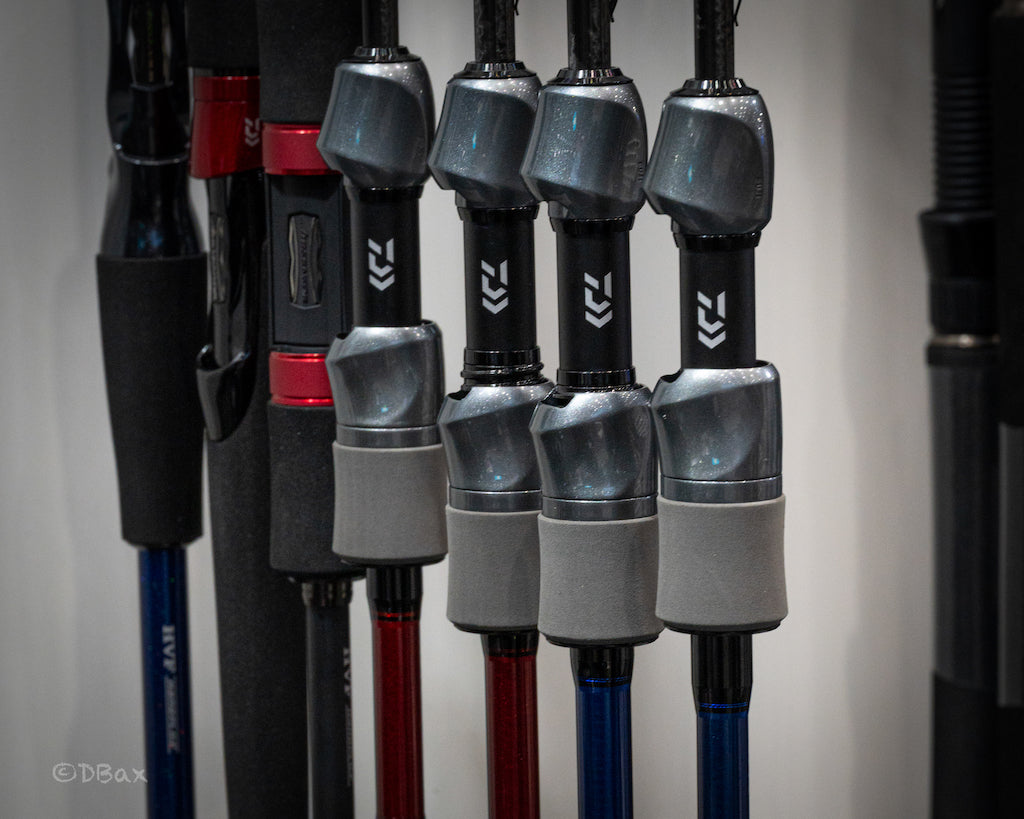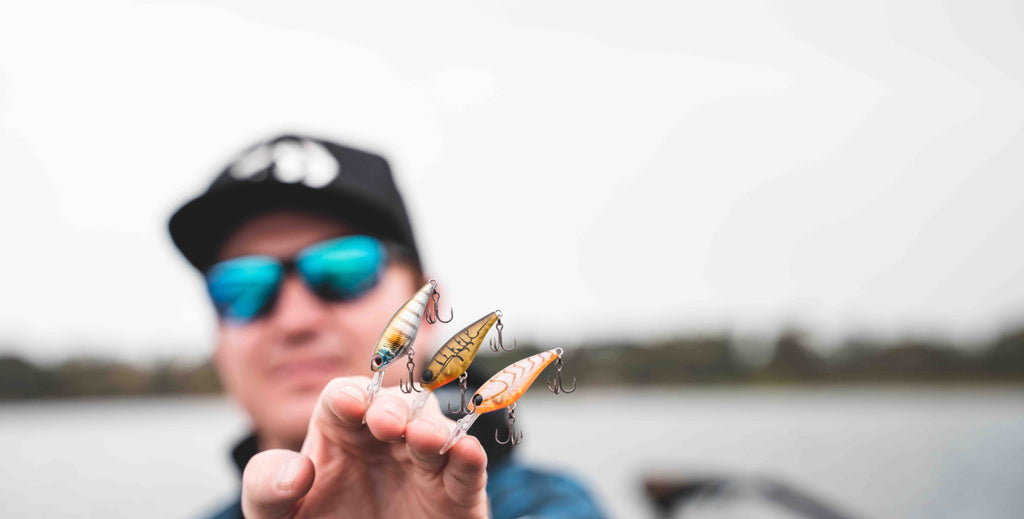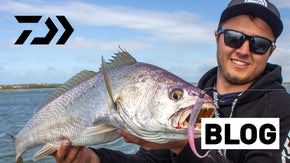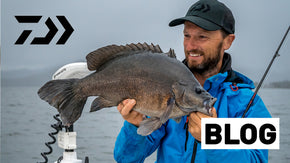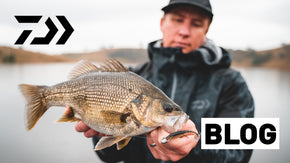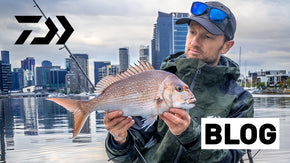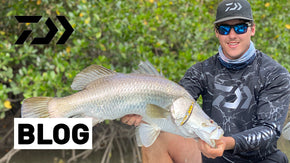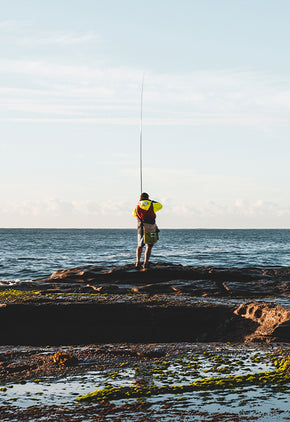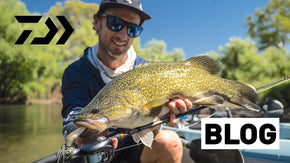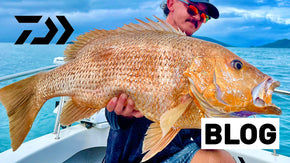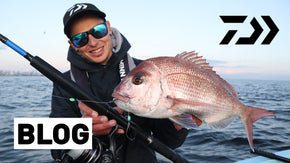Posted 12th April 2024
Catching Australian Bass on Deepwater Soft Plastics
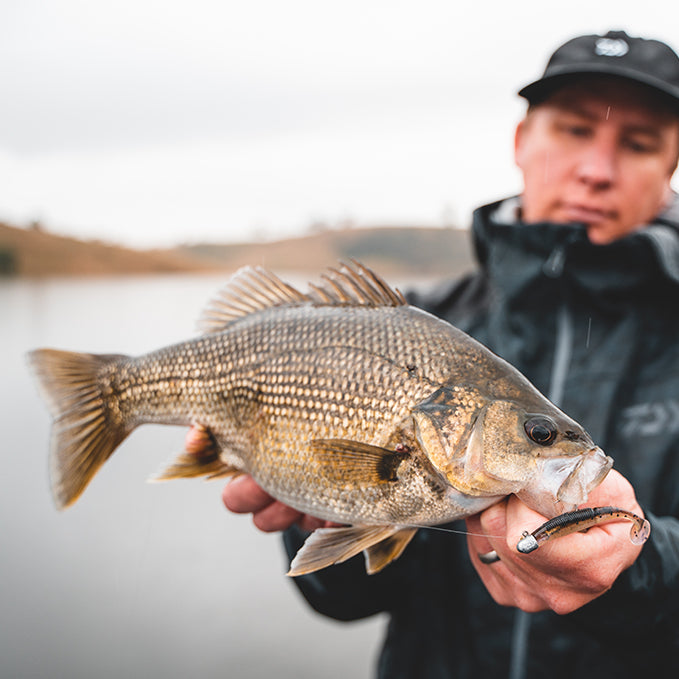

By Charles West
Targeting bass in deep water to me is when bass are in more than 20ft of water, either suspended out in deep water, on the bottom or just off the bottom. Soft plastic fishing for bass in deep water can be lots of fun and can be tough too. Remember that you are trying to trick a living fish to eat an artificial bait.
Soft plastics give a more realistic feel to the bass when they bite it, giving them a natural feel of a baitfish, so they come back and hit it repeatedly. The Bait Junkie material (Elastomax) is soft and robust which suits this type of fishing perfect.
Choosing an Outfit
Rod selection
When choosing an outfit keep in mind you want to be able to cast a long distance to cover a lot of water. A 7-foot rod is a suitable place to start as a standard but also 7ft plus are great options. Most people use a spinning outfit for plastics fishing for bass and rightly so. Here’s what I opt for in an outfit when fishing soft plastics for bass.
* Spin rod 7 ft plus
* Spin reel size 2000-2500
* Main line braid 8-15lb / fluorocarbon 6-8
* Leader 8lb to 12lb fluorocarbon
The right weight and action of the rod is also key to casting the weighted plastic you are using and setting the hook on fish. A medium-light to medium spin rod with a fast taper is great place to start. With a medium-light to medium rod casting 1/4 – 1/2oz is the sweet spot, with most medium-light to medium rods designed to cast weights in the 5-21g weight range.
The reason we are educated to use a fast to extra fast rod when fishing it that they are very responsive allowing you to feel the lightest of bites. It also helps with hookset due to most jigheads having a thicker gauge hook than other lures. A hookset obviously is important to catching and landing fish, the fast taper drives a jighead hook better on a striking hookset. Striking you say, striking is what a big percentage of anglers do when they get bit on a soft plastic, in layman terms it means lifting the rod to set the hook into the fish. Here are some rods in the Daiwa range that are suited to soft plastics fishing for Australian bass.
* 23 TD Black Wild Weasel 701MLFS
* 23 TD Commander Longbolt 722MLXS
* TD Battler Heartland 742MFS-AGS
Reel selection
The reel selection is important for comfit, the right line capacity, and balance of the rod. A 2000 and 2500 spin reel are perfect for the job. Now keep in mind that you need to look at a standard to deep spool reel for line capacity, as you are making long casts and sinking your plastic deep in the water so you will need a reel spool that can hold at least 150 -200m of line. I am generally speaking of the standard gear anglers use for fishing this technique. Below are some reels that are perfect for the job.

Line and Leader
Let us talk about what connects you to the bass in the form of line. A nice smooth PE line is recommended, and the J-Braid Expedition has that covered. Going with a smooth and slick line allows you to make those long casts and keeps water drag on your line to a minimum. When fishing for deep bass it is important to keep in contact with your line or be able to see your line easily. A pound rated line between 8lb to 15lb is a general class of line.
8lb being on the light side of things is for a tough bite with no structure around and wanting a more finesse approach. 15lb being the heavy end of the scale where there is structure involved like sunken trees, or you like a big hook set. Having that extra strength allows you to fight the fish away from the snag with a tighter drag.
Leader selection is important and is dictated by where you are fishing, so a fluorocarbon line is necessary. It has great abrasion resistance on structure, gill rubbing and from mouth rubbing from the bass’ mouth. Fluorocarbon is also invisible under the water, giving you even more stealth in your lure presentation.
My go to is 12lb fluorocarbon. It works well with all different techniques. There is a saying “go light to get the bites”. In some cases, you will have to go down in leader size like 8lb to get the bites on tough days. Some different techniques require that lighter of a leader for better presentation. I will also go up to 20lb leader if I am fishing in sunken trees and I know I’m likely to be wrestling fish out of the trees.
Rule of thumb for leader length is a rod length. This keeps leader knots from being laid on the reel and gives enough cushioning and stretch for hooksets and bite sensitivity. If it is a timid bite you make your leader longer, but when casting try and keep the knot away from the spool of the reel. Longer leaders with give you more stretch to allow the bass to hold the plastic longer in its mouth.
Regularly check your leader if you are catching a few bass because the rubbing of line on a bass’ gill plates and mouth can cause it to fray. You do not want to lose that trophy bass. In extreme times I have known to go to a straight through fluorocarbon spin reel setup when the fish are really shutdown down and biting timidly. This allows maximum stretch, and the bass will hold your plastic, swimming away with it without knowing its attached to your rod and reel. I have won a tournament using this approach.

Bait Junkie Jighead and Soft Plastic Combinations
Here’s a selection of three of my commonly used Bait Junkie jighead weights and their matching soft plastics.
* 1/4 oz Jighead (hook size #1/0 and #2/0)- 2.5” and 3.2” Minnow, 2.5” Grub, 3” Wave Minnow, 2.95” Flick, 3” Prawn
* 3/8 oz Jighead (hook size #2/0 and #3/0)- 3.2” Minnow, 3” Wave Minnow, 3” Prawn
* 1/2 oz Jighead (hook size #3/0)- 3.2” Minnow, 3” Wave Minnow, 3” Prawn
Soft Plastic Colours
When it comes to colours I like to use natural colours that match the baitfish in the lake/dam that I’m fishing. I will however also use some brighter colours because bass can be fussy and often hone in on colours that are very different from the local baitfish. Some of my favorite colours are.
* White bait
* Baby bass
* Pearl gudgeon
* Pearl watermelon
* Electric shad
There are a few different styles of plastics that you can use for catching deep water bass. The most used is a paddle tail minnow shape (Bait Junkie Minnow). The paddle tail gives off a great vibration for the bass to hone in on. Some other shapes are curl tail grubs (Bait Junkie Grub), stickbait (Bait Junkie Wave Minnow) and prawn (Bait Junkie Prawn) styles.
The paddle tail type are my favorite and most successful style of soft plastic for chasing bass. This shape is a great allrounder for every level of fishermen when targeting bass. It’s simple and easy to cast and retrieve and can worked in a variety of different ways. The tail on these plastics puts the action into the lure. There are so many variations of retrieves you can apply to a plastic as we will just talk about the basic but productive ones.

Suspended Bass v Bottom Dwellers
When you are chasing deep water bass in lakes and dam you will come across two types. Suspended bass which sit suspended in the water column and bass that sit on the bottom or close to, unless you find a massive active school where they cover most of the water column.
Suspended bass can be tricky to target but with same simple tips it will make it a little easier. When trying to target these bass you need to know how fast your plastic sinks to the depth of where the bass are suspending. For example, you will find bass suspended at 15ft in 20 plus foot of water and you want to retrieve your lure through that 15ft zone. One effortless way is to drop your rigged plastic directly below the boat and start counting until it gets to the desired depth. If you cannot do so, then sound around to you find hard bottom of your desired depth and count till it hits the bottom.
Now you have your count sorted you can make that long cast and count down that magic number. Keep in mind that when you start winding the lure will start it climb back up the water column. Play around with the count to fine tune where your plastic swims in the water column to get that bite. With a long cast the trajectory creates a slower climb back to the boat and keeps the lure in the strike zone longer.
There are multiple retrieves you can apply but we will keep it to two retrieves that are simple. These two retrieves work well with paddle tailed and curly tailed plastics like the Bait junkie minnow, wave minnow and the grub.
1. Slow roll – a slow or medium paced wind of the reel continuous until it’s back that the boat
2. Roll and pause – same paced winds as above but after a few winds pause and allow the plastic to sink back a couple of seconds which gets it back in the depth of water the bass suspended in.
Bass will follow a lure for a long distance, so it is worth your time to continue the retrieve to it gets to the boat. There is no guaranteed retrieve speed as it can change all the time. Keep changing it on the day until your work out what the fish want.
Bottom dwellers
Bass all so can be found on the bottom or close to, these bass are best caught by your rigged plastic hitting the bottom before you start a retrieve. There is a Pandora’s box of retrieves for these bass and we can talk all day about them, but for the purpose of this blog I will talk about two of the most common.
1. Slow roll – a slow or medium paced wind of the reel continuous until it’s back that the boat
2. Roll and return to bottom – a slow to fast paced wind then stopping to flip the bail arm open and free spool back to the bottom.
The first retrieve is self-explanatory, make your long cast and free spool to the line stops coming off the reel.
The second retrieve can be more complex, but I will try and break it down as much as I can. Make a long cast then free spool your lure to the bottom. At this point you need to know where the bass are sitting by checking your sounder. If the bass are hard on the bottom, it’s as simple as 1 to 3 winds of the reel and then sink the plastic back to the bottom with the reel still engaged (pendulum swing).
Repeat this for about ¾ of your cast then slowly roll back to the boat. If the bass are sitting off the bottom, then you apply more winds whether it’s a fast-winding action or a slow roll (depends on what the bass are reacting on), then stop. From here you can sink your lure back to bottom. This sinking of your lure to the bottom will often trigger a bite from the bass.
The number of winds before you stop all depends on how high the bass are off the bottom. Keep in mind the whole idea is to keep your plastic in the strike zone of the bass as long as possible.
These are just a couple of basic retrieves to start with. From here you can start adding twitches, changing speeds, adding pauses, and so on. Just remember if one doesn’t work keep changing it up until the bass tell you what they want.
That’s a Wrap
There can be a lot of things to considering when fishing and chasing deep water bass on soft plastics is no different. To help keep things simple here are six tips that I keep clear in my mind when chasing bass on plastics. Hopefully these will help you, like they do me. The most important thing to remember is to have fun.
1. If you’re going to choose only one outfit make it a 7’ rod matched to a 2000/2500 reel loaded with 8-15lb PE and 12lb fluro leader
2. Find the bass then keep changing retrieves until the fish bite
3. Go light to get the bite
4. Longer leaders help when it’s a tough bite
5. Try straight through when it’s a tough bite
6. When bass are tight to bottom keep your lure tight to the bottom.


 Contact Us
Contact Us Blog
Blog About
About
